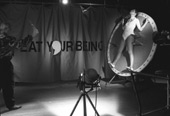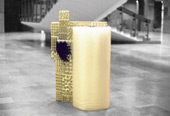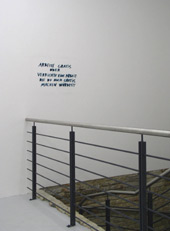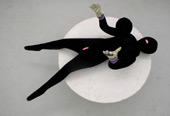THE TYPEWRITER OF THE ILLITERATE
Interview with János Sugár
By Geert Lovink
The Hungarian artist János Sugár produced a stunning short video piece about the popular technology of the Kalashnikov machinegun. He used still photos from mainstream news magazines that are displaying the world's conflicts and morphed them into one, with the Kalashnikov gun as its continuous centrepiece. I heard about the video from the Dutch sociologist Johan Sjerpstra who explained to me why such a minimalist, almost non-video might be interesting in such an overproduction of images. Sjerpstra saw the piece for the first time in Mexico City at "Without emergency exit" exhibition of Centro Multimedia. Sjerpstra was fascinated by the press photos showing the Kalashnikov that turn into each other. The centre of the morph is always the gun. He also noted how special the sound is: the work of a famous jazz drummer, Bobby Previte from NYC, who played once a jazz drummer in Robert Altman's movie Short Cuts. According to Sjerpstra the music track of The Typewriter of the Illiterate is a perfect mixture, a real sound morphing of the sounds of a machine gun and a typewriter. I interviewed János Sugár after a private screening of the tape in Sydney.
GL: How did you come up with the idea to make a video piece about the Kalashnikov?
SJ: I always collected particular images. I call it 'collecting analogies.' For instance, I take a picture whenever I see a broken shop window, or a religious graffiti, or a piece of furniture on the street, etc. I like those series of images, connected only by a similar detail; it represents a special kind of a narrative. For me it is all about the foreground/background issue: what we consider important, the foreground is only a pretext and with the passing time the former background becomes more interesting. Besides taking pictures with my camera I collect press images for the same reason. Among many other topics since the beginning of the 90s I started gathering images of people wearing or using the AK 47 gun I was amazed by the fact that sophisticated weapon systems were never used, they were built, and they were carefully dismantled later on. They boosted national economies and the Americans won the Cold War with them. The development of sophisticated high tech weapons systems has had an enormous impact on the economies and politics of the world, but, thank God, they have never been really used. What has actually been in constant use since the late 40s is the Kalashnikov machine gun. In fifty-five years the approx. 100 million Kalashnikovs have been built and killed much more people than the atomic bomb. Its silhouette became the symbol of revolt and the favorite logo of freedom fighters and terrorists. In Burkina Faso the Kalashnikov for some years was in the national coat of arms. Mozambique has the Kalashnikov beside an open book and a spade in the national flag. In 1995 I had already a large enough collection, but I had no access to the proper hardware. I started morphing the images, but it looked too clumsy and complicated. Only six years later technology, accessible to me, had developed to such an extend that such a simple work could be realised.
GL: Could you tell us something about the history of this world famous machine gun?
SJ: The general history of the machine gun is also interesting. When engineering helpfully solved the technical problem of a fast killing machine, it was considered so immorally savage that for a while it was used only in the colonies, just at the end of WW1 was the machine gun used at the European battlefields. The analogies of the machine gun to the film camera are also obvious. Paul Virilio writes about this in his famous War and Cinema book. Nowadays the infamous AK 47 (later AKM) is a fetish, a cult object, and a successful design piece. Right besides the Jaguar E type the Kalashnikov should be on display in the New York MoMa's design show, and in an instant with this two objects we depicted the 20. Century. The technical specialty of the AKM is its simplicity and efficiency. It has only a few parts; even a village blacksmith could repair it. But its other specialty is maybe more important: as a part of the Soviet power politics, it was licensed to clone, as the IBM PC; it was produced in twenty countries (including Denmark, Sweden, Finland, Italy, Israel, Egypt) and the Kalashnikov made a bloody carrier as the poorest people_s master key to the history. The soviets discovered the distribution of unrest. Need a gun? Here you are. Like selling drugs in the front of a school. With one loading one can kill twenty people, and in societies where ambitions cannot have other safety valves, it is an option for expressing oneself. In Uganda you can have it for a chicken, in Angola for a sack of rice. It is the Esperanto of aggression. Aggression is a status symbol, even in the poorest countries. Somalians have a familiar proverb: "I and Somalia against the world, I and my clan against Somalia, I and my family against the clan, I and my brother against the family, I against my brother." Around 50 Million AKMs are in use around the globe.
GL: What do you know about Mr. Kalashnikov himself? Do you see it as a symbol of Soviet power?
SJ: I have seen him a couple of years ago in a German documentary. My impression was that he is a rather nice person. He said it is the Germans fault that he became a weapon designer, the Germans had such a machine gun and the soviets didn't. He comes from a peasant family of 18 children, he went to the war (to the Great Patriotic War, as they called it), and in 1941 as a 22 years old wounded tank commander made the first sketches of a new weapon in a military hospital. Later the experts refused his first prototype but he was sent to Moscow to study. He did not mentioned there that his parents were exiled by Stalin, and one of his brothers was in a forced labour camp for nine years. And he spent most of his life as a weapon designer living in anonymity in a closed off military area. In some of his early interviews he made after 1990 he speaks about his concerns being a weapon maker, feeling somehow guilty, but as he became later a celebrity he consciously avoids those issues. With his son he produces mainly hunting weapons, and useful goodies, as lawnmower, fire extinguisher, sprinkles; and the newest, NATO compatible, 5.56mm AKM.
GL: The title of the piece, Typewriter of the Illiterate, is amazingly precise and tells half the story. Where did you find the title?
SJ: I found it in a German newsmagazine. Der Spiegel used it as a motto in an ad for a book of Barry Sanders, professor of English at Pitzer College, author of: A Is for Ox, The Collapse of Literacy; and the: Rise of Violence in an Electronic Age and The Private Death of Public Discourse. He said that the gun is the typewriter of the illiterate, or something like this, because I had to translate back from German to English, since I couldn't find the original source. I like the poetical absurdity of this extremely simple and precise definition. Sanders claims that the contemporary erosion of our interior space he claims that the contemporary erosion of our interior space - where the reflective life occurs - accounts for the decline of private ideas and decent public discourse. Why has our culture become increasingly violent? The falling apart of evidencies of identities creates agressivity, and literacy supplies not just criticism, but empathy too.
GL: Would you relate the widespread use of the Kalishnikov with a rise of a global civil war, a conflict of 'all against all'? Do you see any use of the machinegun-type of art? I'd relate the Kalashnikov somehow with remote conflicts. But then. the gun was used extensively during the 90s Yugoslav wars. That's pretty close to Budapest. How near is the Kalashnikov?
SJ: Maybe the gun itself not, but the concept of the Kalashnikov is very near. In the Western hemisphere we have a broad choice of handguns, Kalashnikov is only the solution for historically unbalanced places, as one have to use a Landrover in Africa, not a Ferrari. The interesting is that the Kalashnikov fits into the process as a once special and expensive product gets cheaper and cheaper through the mass usage. The watch was a rarity and now you can have it in every corner. In this sense the Kalashnikov, as the ultimate attention generator, is a similar consumer product, an element of a certain lifestyle. We live much more in 'an all against all' situation than ever because the final frontier of all consumer products is the single individual. Everyone has to have one photo/video camera, telephone, etc. on his/her body. We are individually fragmented communication centres, and a gun is indeed one of many possible direct communication accessories.
THE TYPEWRITER OF THE ILLITERATE
János Sugár 2001, digital video, 8 Min
contact: sj@c3.hu
János Sugár
DO YOU KNOW MY METHOD?
35mm, b/w, 8 Min. 1998, BBS production
digital video, 8 Min. 2002
photo: J. Sugár: Erstes und letztes Bild des Films Kennen Sie meine Methode?, 1998
/.../ Ein früher Text von Lacan endet mit dem Satz 'Eat your Being!'. Logos und Nymphen; das Bacchanal des Logos. Er stammt aus einem unglaublich aggressiven frühen Vortrag Lacans, noch aus den vierziger Jahren, wenn ich mich richtig erinnere, er steht dort als letzter Satz, und zwar auch im Original auf Englisch. /.../ (Johan Sjerpstra, Thu, 26 Feb 1998 22:38:14 +0100)
/.../ Ich suchte nach dem Originaltext und habe etwas in L'Éthique de la psychanalyse (Séminaire VII) gefunden, das ist aber meines Erachtens nicht die richtige Lösung der Frage. Lacan nämlich sagt dort “Manger la livre" und fügt noch hinzu, das sei aus den Offenbarungen. Da ist dieser gewisse Abschnitt aus Kapitel 22 (die Notwendigkeit des Glücks, die analytische Verheißung). Was bedeutet nun dieses höchst suggestive Bild in den Offenbarungen, “Du sollst das Buch essen"? Falls nicht das Buch die Verkörperung selbst wird, und zwar die Verkörperung des Bezeichnenden, dann wird es zur Stütze der eigentlichen apokalyptischen Schöpfung. In diesem Fall ist Gott selbst, der Gegenstand der Verkörperung, der Bezeichnende. (Johan Sjerpstra, Mon, 30 Mar 1998 01:26:27 +0200)
140. Or, to return to a more moderate tone, let us say, as in the quip with which-along with some of you who had followed us to the Zurich Congress last year-we rendered homage to the local password, the signifier's answer to whoever interrogates it is: "Eat your Dasein." (Jacques Lacan: Seminar on 'The Purloined Letter)
János Sugár
Monument of No Erase, 2006
A monument to the impossibility of disposal
The classical sculpturing is one of the most costly artforms that is maybe only topped by land-art or Hollywood. Basically it is so expensive because its nature is in permanence. As our long lasting materials are costly only the Power can finace itself the luxury to errect the monument of its selfdepiction.
When a sculpture placed in a public space has to signify a particular location or event the obsession of the Power with its selfrepresentation will through a particular social context be charged by means of the symbolic meaning of the monument. A monument outlives itself and its context physically when the ruling ideology changes. When a political turnaround occurs then the reference points connected to the past are rearranged and put that which for some reason was intended as eternal into motion.
In the best case scenario monuments, loosing their meaning are transformed and without the original context they only remain standing, and sometimes sitting human figures. In other cases they begin to move, they are being relocated, in certain situations they are taken to other culture‘s museums. In the worst case the once from valuable and lasting materials produced works end on the rubbish heap.
How is it possible to turn a symbol that has lost its meaning - that has almost expired and was degraded to rubbish – into a new symbol?
The gigantic monument of the ‘Empires Muse’ transforms into the monument of an incidental irrelevance. From the Austria monument – a macro symbol – once symbolizing the Empire comes now the monument of a micro event in which two worthless products meet: the secration, the result of healthy bowel functions, the organic waste – and the cigarette butt, as prime example for the anorganic waste of our civilization. The recycled Austria stands ready for the next loss of context!






